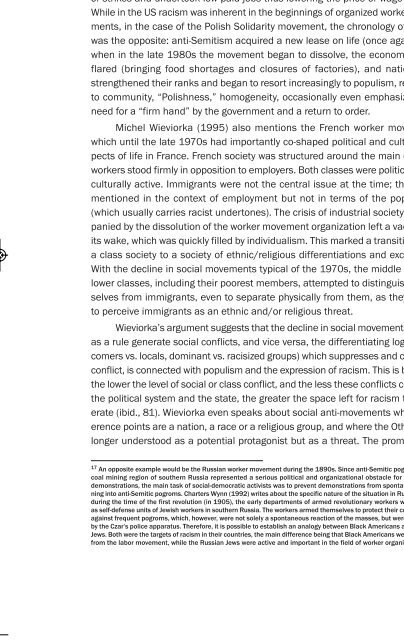The Scars of the Erasure_web
The Scars of the Erasure_web
The Scars of the Erasure_web
- No tags were found...
Create successful ePaper yourself
Turn your PDF publications into a flip-book with our unique Google optimized e-Paper software.
<strong>Erasure</strong>_4a 10.1.11 20:29 Page 33REGISTERED AS WORKERS, ERASED AS NON-SLOVENES33attributes (Wieviorka 1995). For example, <strong>the</strong> American labor movement wasinitially organized (1881) as a white workers’ movement exclusively. As late as1935, black workers were excluded from trade unions, while at <strong>the</strong> same timeaccused <strong>of</strong> betraying <strong>the</strong> working class because <strong>the</strong>y did not observe <strong>the</strong> rules<strong>of</strong> strikes and undertook low paid jobs thus lowering <strong>the</strong> price <strong>of</strong> wage labor. 17While in <strong>the</strong> US racism was inherent in <strong>the</strong> beginnings <strong>of</strong> organized worker movements,in <strong>the</strong> case <strong>of</strong> <strong>the</strong> Polish Solidarity movement, <strong>the</strong> chronology <strong>of</strong> eventswas <strong>the</strong> opposite: anti-Semitism acquired a new lease on life (once again) onlywhen in <strong>the</strong> late 1980s <strong>the</strong> movement began to dissolve, <strong>the</strong> economic crisisflared (bringing food shortages and closures <strong>of</strong> factories), and nationalistsstreng<strong>the</strong>ned <strong>the</strong>ir ranks and began to resort increasingly to populism, recurringto community, “Polishness,” homogeneity, occasionally even emphasizing <strong>the</strong>need for a “firm hand” by <strong>the</strong> government and a return to order.Michel Wieviorka (1995) also mentions <strong>the</strong> French worker movement,which until <strong>the</strong> late 1970s had importantly co-shaped political and cultural aspects<strong>of</strong> life in France. French society was structured around <strong>the</strong> main conflict:workers stood firmly in opposition to employers. Both classes were politically andculturally active. Immigrants were not <strong>the</strong> central issue at <strong>the</strong> time; <strong>the</strong>y werementioned in <strong>the</strong> context <strong>of</strong> employment but not in terms <strong>of</strong> <strong>the</strong> population(which usually carries racist undertones). <strong>The</strong> crisis <strong>of</strong> industrial society accompaniedby <strong>the</strong> dissolution <strong>of</strong> <strong>the</strong> worker movement organization left a vacuum inits wake, which was quickly filled by individualism. This marked a transition froma class society to a society <strong>of</strong> ethnic/religious differentiations and exclusions.With <strong>the</strong> decline in social movements typical <strong>of</strong> <strong>the</strong> 1970s, <strong>the</strong> middle and <strong>the</strong>lower classes, including <strong>the</strong>ir poorest members, attempted to distinguish <strong>the</strong>mselvesfrom immigrants, even to separate physically from <strong>the</strong>m, as <strong>the</strong>y beganto perceive immigrants as an ethnic and/or religious threat.Wieviorka’s argument suggests that <strong>the</strong> decline in social movements, whichas a rule generate social conflicts, and vice versa, <strong>the</strong> differentiating logic (newcomersvs. locals, dominant vs. racisized groups) which suppresses and concealsconflict, is connected with populism and <strong>the</strong> expression <strong>of</strong> racism. This is because<strong>the</strong> lower <strong>the</strong> level <strong>of</strong> social or class conflict, and <strong>the</strong> less <strong>the</strong>se conflicts co-shape<strong>the</strong> political system and <strong>the</strong> state, <strong>the</strong> greater <strong>the</strong> space left for racism to proliferate(ibid., 81). Wieviorka even speaks about social anti-movements whose referencepoints are a nation, a race or a religious group, and where <strong>the</strong> O<strong>the</strong>r is nolonger understood as a potential protagonist but as a threat. <strong>The</strong> promoters <strong>of</strong>17 An opposite example would be <strong>the</strong> Russian worker movement during <strong>the</strong> 1890s. Since anti-Semitic pogroms in <strong>the</strong>coal mining region <strong>of</strong> sou<strong>the</strong>rn Russia represented a serious political and organizational obstacle for strikes anddemonstrations, <strong>the</strong> main task <strong>of</strong> social-democratic activists was to prevent demonstrations from spontaneously tur -ning into anti-Semitic pogroms. Charters Wynn (1992) writes about <strong>the</strong> specific nature <strong>of</strong> <strong>the</strong> situation in Russia, whereduring <strong>the</strong> time <strong>of</strong> <strong>the</strong> first revolution (in 1905), <strong>the</strong> early departments <strong>of</strong> armed revolutionary workers were formedas self-defense units <strong>of</strong> Jewish workers in sou<strong>the</strong>rn Russia. <strong>The</strong> workers armed <strong>the</strong>mselves to protect <strong>the</strong>ir communitiesagainst frequent pogroms, which, however, were not solely a spontaneous reaction <strong>of</strong> <strong>the</strong> masses, but were instigatedby <strong>the</strong> Czar’s police apparatus. <strong>The</strong>refore, it is possible to establish an analogy between Black Americans and RussianJews. Both were <strong>the</strong> targets <strong>of</strong> racism in <strong>the</strong>ir countries, <strong>the</strong> main difference being that Black Americans were excludedfrom <strong>the</strong> labor movement, while <strong>the</strong> Russian Jews were active and important in <strong>the</strong> field <strong>of</strong> worker organization.


